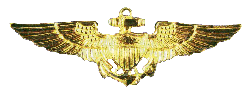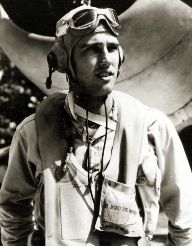
General Marion E. Carl
![]()

 The first
Marine ace was a World War II pilot, Captain Marion E. Carl of Marine Fighter Squadron 223
(VMF-223). Carl would eventually shoot down 18.5 Japanese aircraft, achieve several
postwar performance records in early jet aircraft, lead a Marine amphibious landing ashore
in Vietnam and retire as a major general.
The first
Marine ace was a World War II pilot, Captain Marion E. Carl of Marine Fighter Squadron 223
(VMF-223). Carl would eventually shoot down 18.5 Japanese aircraft, achieve several
postwar performance records in early jet aircraft, lead a Marine amphibious landing ashore
in Vietnam and retire as a major general.
As a member of the ill-fated VMF-221 during the Battle of Midway, he earned his first Navy Cross while leading an attack against a vastly superior number of Japanese bombers and fighter aircraft. At 5:34 A.M. on June 4th, a Navy Catalina flying boat spotted the Japanese attack force and radioed: "Many enemy planes heading Midway." These were the carrier based fighters and bombers which were to "soften up" the island before the planned invasion. There were twenty-eight Marine fighter planes on Midway under the command of Major Floyd B. Parks. Nineteen of these were old Brewster F2A Buffalo fighters. Immediately Major Parks took off with seven Buffalos and five Wildcats to intercept the enemy attacking force. The rest of the fighters were ordered up too, but held in reserve.
When Parks first spotted the enemy formation at 14,000 feet, he saw over 100 fighter planes and bombers. The Zero escort was beneath the bombers, apparently not expecting fighter opposition. The Marine fighters peeled off and roared into the Vals, all guns blazing. Several of the Japanese bombers were hit, and dropped away toward the sea. But then the Zeros saw the Marine fighter planes and climbed to meet the Wildcats and sluggish Buffalos. The Marine pilots didn't have a chance. The dancing Zeros cut up the brave defenders. Not only were the marines heavily outnumbered, but their planes could not match the performance of the Japanese fighters.
In a vicious dogfight the Americans lost plane after plane. In Parks' group only two pilots survived. One of them was Captain Marion Carl. He destroyed one Zero on his first pass, but as he climbed for altitude again, other Zeros got on his tail. He nosed over, rammed everything to the firewall, and pulled away. A Wildcat could at least outdive a Zero. In this way Captain Carl managed to escape. On his way home he made another attack on three Zeros below him and sent one down, burning and out of control.
The rest of the Marine fighter planes joined Major Parks' fight, but to no avail. After the "all clear," the Midway radio called: "Fighters land, refuel by divisions...." No fighters landed. Then came the call, "All fighters land and reservice." only ten planes came back, and only two would ever fly again. It was the heaviest loss the Marines suffered in a single air battle during the entire war. One of our pilots said bitterly afterward that the Buffalo "should be in Miami as a training plane." Capt. Carl flew one of only two planes sent up in the second defensive sortie from Midway.
Along with some other survivors of VMF-221, he was assigned to VMF-223, and headed to Guadalcanal on August 20 in the very first group of American fliers to land there. Four days later, during the Battle of the Eastern Solomons, VMF-223 intercepted six torpedo planes and fifteen Zeros from the Ryujo. They caught the Japanese planes between Malaita and Florida at 9,000 feet, and shot down all the torpedo planes, while the Zeros got three Americans. Marion Carl claimed two torpedo planes and one Zero. He became an ace on 26 August 1942, when he was jumped while coming in for a landing at Henderson Field. He cranked up his wheels and engaged the audacious Zero over the beach - exploding his quarry before hundreds of witnesses.
During an aerial fight off the coast of Guadalcanal on September 9, he was forced to bail out of his shot-up Wildcat and was losing his battle to swim ashore against the tide, when he was picked up by friendly natives in a canoe. After five days with the natives, he finally made his way back to his base. General Geiger, the Marine air commander, informed Captain Carl that Major Smith, his rival ace, had just shot down his 16th plane, while Carl only had 12. "What are we going to do about that?" the General asked. "Goddammit, General, ground him for five days!" On October 1, Admiral Nimitz awarded Carl, Galer, and Smith Navy Crosses. But the grinding attrition continued; two days later, Carl led up the remaining four planes of -223, shooting down a Zero, as did two others. During the period from late August through November 1942, the Marine pilots faced almost daily combat, and some of them, like Carl, Smith, and Foss ran up large scores. He returned to the United States on 21 October 1942.
In July 1943, he left San Francisco on his second tour of combat duty, in which he led -223 and scored two more kills while flying Corsairs. This tour took him through the Hawaiian Islands to New Hebrides, Vella Lavella in the Solomon Islands, Guadalcanal and Emirau. In November 1944, he returned from the Pacific area, having earned a total of two Navy Crosses, three Distinguished Flying Crosses, and 13 Air Medals. Next, he was assigned duty with Flight Test, Naval Air Test Center, Patuxent River, Maryland. On V-J Day, 14 August 1945, he was promoted to Lieutenant Colonel. As a test pilot, he was the first Marine Corps pilot to land a jet aircraft, an F-80 Shooting Star, aboard an aircraft carrier on 1 November 1946. He was also the first living Marine to be inducted into Naval Aviation Test Pilot's Hall of Fame.
Tragically, General Carl was shot and killed by an intruder in his Oregon home in June, 1998. He was 83 years old.